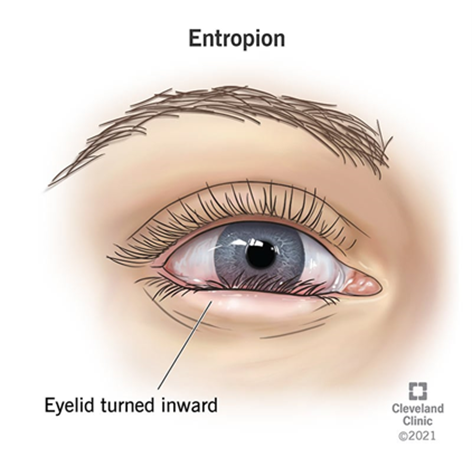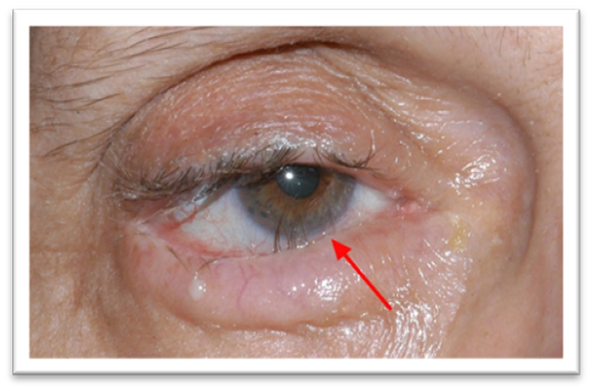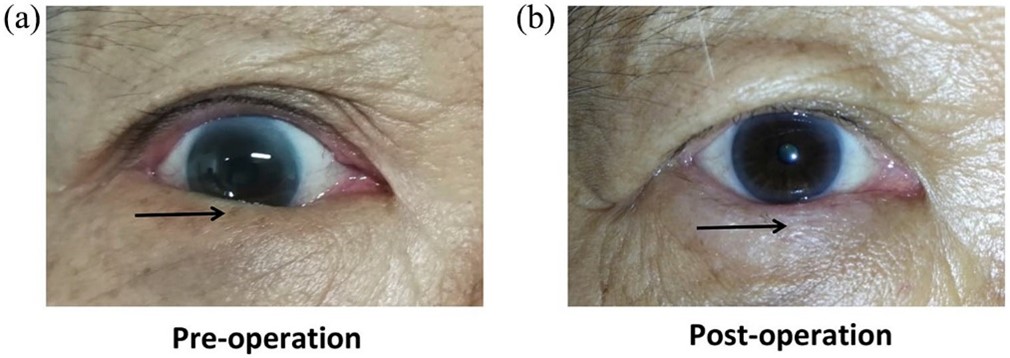
Entropion is an abnormality in the position of the eyelid which rolls inward towards the eye. This condition can cause the eyelashes to face inward towards the surface of the eyeball and then touch and rub against the surface of the eyeball, causing irritation to the surface of the eye and discomfort. This disorder is one of the most common eyelid position abnormalities, especially in older people. Entropion can cause damage to the cornea, which is the transparent part on the front surface of the eyeball and also to the conjunctiva of the eye, resulting in impaired vision, infection, inflammation, and even blindness, requiring immediate treatment.
The Important Role of the Eyelids
One of the main functions of the eyelids is to protect the eyes and prevent foreign objects from entering the eyes. Another important function of the eyelids is to regularly spread tears across the surface of the eye to keep it moist. The eyelids also play a role in producing eye blinks. With every blink of the eyelid, there is a pumping or squeezing mechanism that expresses tears on the surface of the eye, so that it remains comfortable and clear when looking. Apart from that, the eyelids also help push tears towards the tear drainage channel so that they are used and drained properly. Therefore, if someone has an entropion disorder, then there can be disturbances in these functions. Apart from that, disturbances in the function of the eyelids can also result in vision problems and even blindness in the future if treatment or treatment is not immediately carried out.
Epidemiology of Entropion
Entropion most commonly occurs at an average age of 60 years and over. The prevalence increases as a person gets older. Entropion occurs more often in women with a prevalence of 2.4% compared to men (1.9%). Entropion occurs more often on the lower lids, but can also occur on the upper lids. Apart from that, entropion can also be related to conditions resulting from traumatic lacerations and infections of the eyelids.

Causes of Entropion
- Entropion is most commonly caused by weakness of the muscles around the eyes and eyelids. As we age, the muscles under the eyes tend to weaken, and the tendons stretch. Loose skin and shifts in fat on the eyelids that occur during the aging process also aggravate this condition.
- Previous scars or surgery. Scarred skin resulting from chemical burns, trauma or surgery can cause pulling and distort the normal curve of the eyelid.
- Eye infections. The eye infection, called trachoma, is common in many developing countries in Africa, Asia, Latin America, the Middle East and the Pacific Islands. This disease can cause scarring of the inner eyelids, leading to entropion and even blindness.
- Eye irritation caused by dry eyes or inflammation can cause a person to rub their eyelids or squeeze them shut. This can cause spasm of the eyelid muscles and rolling of the edge of the eyelid inward towards the cornea (spastic entropion).
- Complications of developmental disorders at birth. If entropion is present at birth (congenital), it is usually caused by an extra fold of skin on the eyelid that causes the direction of the eyelashes to change.
Signs and Symptoms of Entropion
Someone who experiences entropion usually complains of:
- Sensation like a lump, gritty, foreign object in the eye
- Excessive watery eyes
- Exit a lot of dirt or mucus from the eye
- Dry feeling in the eyes, sensitive to wind
- Discomfort, pain, irritation and red eyes
- Sensitive to light
- Blurred vision

Figure 2. Entropion in old age. The red arrow shows the eyelashes pointing inward and touching the surface of the eyeball.
Complications of Entropion
Entropion that is treated too late or is not treated properly can potentially cause complications, including:
- Eye infections
- Corneal injuries and corneal ulcers
- Permanent blindness
Entropion Treatment and Management
Treatment depends on what is causing the entropion. Non-surgical treatments are aimed at relieving symptoms and preventing the eyes from damage. When inflammation or active infection causes entropion (spastic entropion), the eyelids can return to their normal shape by treating the inflamed or infected eye. Giving lubricating eye drops or ointment can help keep the surface of the eyeball smooth and lubricated. However, entropion tends to persist even after other conditions have been treated.
Surgery / surgical procedures called entropion correction surgery are generally required to completely correct entropion.
Entropion Correction Surgery
Entropion correction surgery aims to improve the position of the eyelid so that it returns to its normal position. The eyelashes will return outwards away from the surface of the eyeball, this will make these structures return to their normal position. In this way, the surface of the eyeball will be protected and protected from more serious damage, infection, inflammation and irritation which has the potential to disrupt vision and even blindness. Entropion correction surgery is carried out by an ophthalmologist who is trained in the field of eyelid surgery. In most age-related entropion, the eyelid surgeon will remove a small portion of the eyelid tissue. This aims to help tighten the tendons and muscles that are loose and cause entropion. After that the doctor will place several stitches in the outer corner of the eye or right on the eyelid. Before surgery, the eyelid area will be given local anesthesia to numb the eyelids and the surrounding area so that the surgical procedure can be more comfortable for the patient.
After entropion correction surgery, the eyelid area will usually be slightly swollen and bruised. After surgery, the patient will be given medication to help with the post-operative recovery process. Usually patients are advised to keep post-operative sutures really clean, use medication regularly, and apply cold compresses to the eyelids. After surgery, the patient will be scheduled for several follow-up appointments so that the ophthalmologist can carry out post-operative follow-up .
How long does it take to recover after entropion correction surgery?
Shortly after entropion correction surgery, the eyelids may feel congested. But as the healing process begins to occur, the feeling will gradually change to become more comfortable. The stitches are usually removed about a week after surgery. Swelling and bruising will usually disappear in about two weeks.

Figure 3. Conditions before and after entropion correction surgery. (a) before entropion correction surgery: the lower eyelid rolls inward (black arrow). (b) after entropion correction surgery: the eyelid returns to its normal position (black arrow).
Prevention of Entropion
Generally, entropion cannot be prevented. As we get older, the muscles throughout our body become weaker, and this is unbearable. Likewise, the eyelid muscles will weaken with age. Therefore, regular consultations and examinations with an ophthalmologist are very necessary to find out appropriate prevention methods that are appropriate to the risk factors you have. Entropion caused by trachoma infection can be prevented by avoiding traveling to areas where trachoma cases occur. If the eyes become red and irritated after someone visits an area with a trachoma infection, evaluation and treatment should be carried out immediately.
When should you see an eye specialist?
If someone experiences: red eyes, pain, a feeling of a lump like grit or like there is a foreign object in the eye, sensitivity to light and/or wind, and vision begins to decline. If these symptoms occur and begin to be experienced, you should not delay any longer, immediately have your eye condition checked by an ophthalmologist.
Article written by dr. Andreas Surya Anugrah, Sp.M, AIFO-K, CP.NLP (Eye Specialist at EMC Hospital Cikarang).
